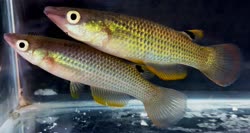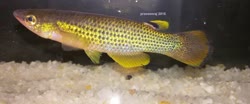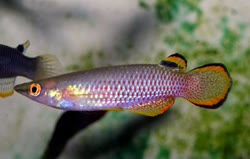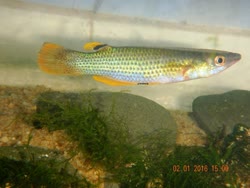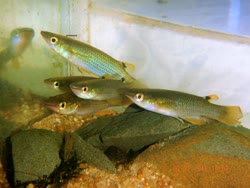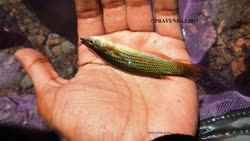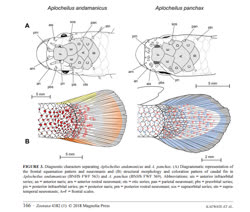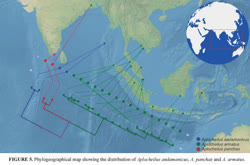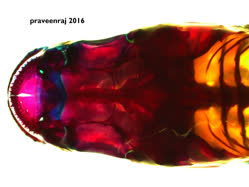|
|
"In his work on the fishes of the Andaman Islands, Francis Day (1870) collected large-sized specimens of Aplocheilus from
the south Andamans. Despite differences in the size and dorsal-fin ray counts, Day refrained from recognising the Andaman
Aplocheilus as a distinct species and considered it as Aplocheilus panchax, a species distributed in the Ganges delta
and across the eastern coast of mainland India. However, Day mentioned the differences in fin-ray counts between these
two populations. Subsequently Köhler (1906) described the Andaman population as Haplochilus andamanicus (now in
Aplocheilus), referring to the diagnostic characters initially discovered by Day. This species failed to receive recognition
from taxonomists, because of the uncertainty regarding the validity of the species and its questionable synonymy with A.
panchax. In this study, based on morphological and molecular evidence, we demonstrate that A. andamanicus is indeed a
distinct and valid species, which can easily be diagnosed from the widespread A. panchax." - Katwate et al. 2018
- DOI: 10.11646/zootaxa.4382.1.6
"In this study, based on morphological and molecular evidence, we demonstrate that A. andamanicus is indeed a
distinct and valid species, which can easily be diagnosed from the widespread A. panchax."
Aplocheilus andamanicus differs
from topotypic A. panchax by the combination of the following characters: the most discussed (Day, 1878; Köhler
1906; Herre, 1939) being body size difference, A. andamanicus grows much larger in size (it is probably the largest
Aplocheilus in South and South-East Asia), to at least 74.8 mm SL (vs. smaller in size); 9–10 dorsal-fin rays (vs.
6–8); 15 principal and 18–19 procurrent caudal-fin rays (vs. 12–13 principal and 12 procurrent caudal-fin rays);
dorsal fin with posterior margin widely separated from caudal-fin base or hypural plate (vs. extending beyond
vertical through caudal base or hypural plate); pectoral fin extending beyond vertical through anterior one-third of
pelvic fin (vs. pectoral fin extending to half the length of pelvic fin); pelvic fin nearly reaching vent when
adpressed but well separated from anterior base of anal fin (vs. pelvic fin extends beyond vent reaching anterior
base of anal fin); caudal-fin margin rounded (vs. more oval in) (Fig. 3); lateral line system incomplete extending up
to the vertical from posterior margin of dorsal fin base (vs. lateral line system complete, reaching caudal-fin base);
total vertebrae 33–34 (vs. 28–30); pre-anal vertebrae 13–14 (vs. 11–12); caudal vertebrae 18–19 (vs. 14–16);
median scale “A” of frontal squamation pattern smaller than scale “B” (vs. median scale “A” significantly larger
than scale “B”) (Fig. 3); single anterior rostral and posterior rostral neuromasts (vs. 2 anterior rostral and 3
posterior rostral neuromasts). Day (1878) reported a total of up to 11 dorsal-fin rays in his Andaman collection, a
character that was subsequently used by Köhler (1906) to diagnose A. andamanicus. Radiographs of Day’s
collection (syntypes, BMNH 1889.2.1.2107-2110) and cleared and stained topotypes (BNHS FWF 384 & 385) of
A. andamanicus showed, however, only 9–10 dorsal-fin rays. In any case, the dorsal-fin ray count is still valid and
is the most significant diagnostic character that distinguishes A. andamanicus from A. panchax (9–10 vs. 7–8).Furthermore, A. andamanicus can easily be distinguished from A. panchax based on its unique coloration
pattern including, dorsal fin extremity deep yellow or saffron (vs. blue in A. panchax); distal half of anal fin hyaline
in female or studded with three longitudinal rows of vertically elongated red dots (vs. distal half of anal fin deep
iridescent blue); pelvic fin yellow (vs. hyaline in A. panchax); and caudal fin periphery hyaline or subtle red (vs.
deep iridescent blue in A. panchax). Both species are also genetically distinct, with a cox1 distance of 9.6–10.8%
(Table 2) - Katwate et al. 2018
|
